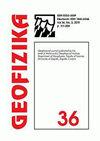坡度、线密度和水量收支分析在克罗地亚slunj河复杂岩溶集水区圈定中的作用
IF 1.1
4区 地球科学
Q4 GEOCHEMISTRY & GEOPHYSICS
引用次数: 0
摘要
由于喀斯特含水层对地表污染物的高度脆弱性,一个精确定义的集水区具有最高的优先级。本文讨论了复杂岩溶集水区圈定过程中边坡倾角、岩溶密度分析和水量收支分析的影响。为了确定岩性单元的水文地质作用,将边坡倾角和白云石密度剖面结合在水文地质剖面上,用岩溶作用程度来描述岩性单元的渗透率。通过水量收支分析对岩溶集水区圈定面积进行了验证。流程图显示了用于确定水文地质行为和划定复杂喀斯特集水区(克罗地亚slunj本文章由计算机程序翻译,如有差异,请以英文原文为准。
The role of slope inclination, doline density and water budget analysis in delineation of complex karst catchment area of Slunjčica River (Croatia)
Due to the high vulnerability of the karst aquifer to the surface contaminants, a precisely defined catchment area has the highest priority. In this study, the influence of slope inclination, the doline density analysis, and the water budget analysis in the delineation process of a complex karst catchment area is discussed. To define hydrogeological role of lithological units, cross sections of slope inclination and doline density were combined with hydrogeological cross sections, while the degree of karstification was used to describe the permeability of rock units. The verification of karst catchment delineation area was performed with water budget analysis. The methodology used for the determination of hydrogeological behavior and delineation of a complex karst catchment area (Slunjčica River basin, Croatia) is shown with the flow diagram. It has been found that the highest doline density appears in the range from 0 to 1° of the slope inclinations, and that it decreases with a higher slope degree. Although the results of this study confirm that even with the relatively small number of input data it is possible to define the karst catchment area, it must be emphasized that the doline density analysis presents an indispensable tool in the research related to the definition of karst catchment areas.
求助全文
通过发布文献求助,成功后即可免费获取论文全文。
去求助
来源期刊

Geofizika
地学-地球化学与地球物理
CiteScore
1.60
自引率
0.00%
发文量
17
审稿时长
>12 weeks
期刊介绍:
The Geofizika journal succeeds the Papers series (Radovi), which has been published since 1923 at the Geophysical Institute in Zagreb (current the Department of Geophysics, Faculty of Science, University of Zagreb).
Geofizika publishes contributions dealing with physics of the atmosphere, the sea and the Earth''s interior.
 求助内容:
求助内容: 应助结果提醒方式:
应助结果提醒方式:


